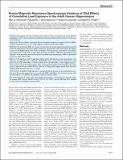| dc.contributor.author | Weisskopf, Marc G. | |
| dc.contributor.author | Hu, Howard | |
| dc.contributor.author | Sparrow, David | |
| dc.contributor.author | Lenkinski, Robert E. | |
| dc.contributor.author | Wright, Robert O. | |
| dc.date.accessioned | 2011-05-16T23:26:42Z | |
| dc.date.issued | 2007 | |
| dc.identifier.citation | Weisskopf, Marc G., Howard Hu, David Sparrow, Robert E. Lenkinski, and Robert O. Wright. 2007. Proton Magnetic Resonance Spectroscopic Evidence of Glial Effects of Cumulative Lead Exposure in the Adult Human Hippocampus. Environmental Health Perspectives 115(4): 519-523. | en_US |
| dc.identifier.issn | 0091-6765 | en_US |
| dc.identifier.uri | http://nrs.harvard.edu/urn-3:HUL.InstRepos:4889574 | |
| dc.description.abstract | Background: Exposure to lead is known to have adverse effects on cognition in several different populations. Little is known about the underlying structural and functional correlates of such exposure in humans. Objectives: We assessed the association between cumulative exposure to lead and levels of different brain metabolite ratios in vivo using magnetic resonance spectroscopy (MRS). Methods: We performed MRS on 15 men selected from the lowest quintile of patella bone lead within the Department of Veterans Affairs’ Normative Aging Study (NAS) and 16 from the highest to assess in the hippocampal levels of the metabolites N-acetylaspartate, myoinositol, and choline, each expressed as a ratio with creatine. Bone lead concentrations—indicators of cumulative lead exposure—were previously measured using K-X-ray fluorescence spectroscopy. MRS was performed on the men from 2002 to 2004. Results: A 20-μg/g bone and 15-μg/g bone higher patella and tibia bone lead concentration—the respective interquartile ranges within the whole NAS—were associated with a 0.04 [95% confidence interval (CI), 0.00–0.08; p = 0.04] and 0.04 (95% CI, 0.00–0.08; p = 0.07) higher myoinositol-to-creatine ratio in the hippocampus. After accounting for patella bone lead declines over time, analyses adjusted for age showed that the effect of a 20-μg/g bone higher patella bone lead level doubled (0.09; 95% CI, 0.01–0.17; p = 0.03). Conclusions: Cumulative lead exposure is associated with an increase in the myinositol-to-creatine ratio. These data suggest that, as assessed with MRS, glial effects may be more sensitive than neuronal effects as an indicator of cumulative exposure to lead in adults. | en_US |
| dc.language.iso | en_US | en_US |
| dc.publisher | National Institute of Environmental Health Sciences | en_US |
| dc.relation.isversionof | doi:10.1289/ehp.9645 | en_US |
| dc.relation.hasversion | http://www.ncbi.nlm.nih.gov/pmc/articles/PMC1852692/pdf/ | en_US |
| dash.license | LAA | |
| dc.subject | bone lead | en_US |
| dc.subject | choline | en_US |
| dc.subject | glia | en_US |
| dc.subject | hippocampus | en_US |
| dc.subject | myoinositol | en_US |
| dc.subject | N-acetylaspartate | en_US |
| dc.subject | neuronal viability | en_US |
| dc.subject | proton MRS | en_US |
| dc.title | Proton Magnetic Resonance Spectroscopic Evidence of Glial Effects of Cumulative Lead Exposure in the Adult Human Hippocampus | en_US |
| dc.type | Journal Article | en_US |
| dc.description.version | Version of Record | en_US |
| dc.relation.journal | Environmental Health Perspectives | en_US |
| dash.depositing.author | Weisskopf, Marc G. | |
| dc.date.available | 2011-05-16T23:26:42Z | |
| dash.affiliation.other | SPH^Environmental+Occupational Medicine+Epi | en_US |
| dash.affiliation.other | SPH^Student Stipends | en_US |
| dash.affiliation.other | HMS^Medicine-Brigham and Women's Hospital | en_US |
| dash.affiliation.other | HMS^Medicine-Brigham and Women's Hospital | en_US |
| dash.affiliation.other | SPH^Environmental+Occupational Medicine+Epi | en_US |
| dash.affiliation.other | HMS^Pediatrics-Children's Hospital | en_US |
| dc.identifier.doi | 10.1289/ehp.9645 | * |
| dash.contributor.affiliated | Lenkinski, Robert E. | |
| dash.contributor.affiliated | Weisskopf, Marc | |
| dash.contributor.affiliated | Wright, Robert | |
| dash.contributor.affiliated | Sparrow, David | |


